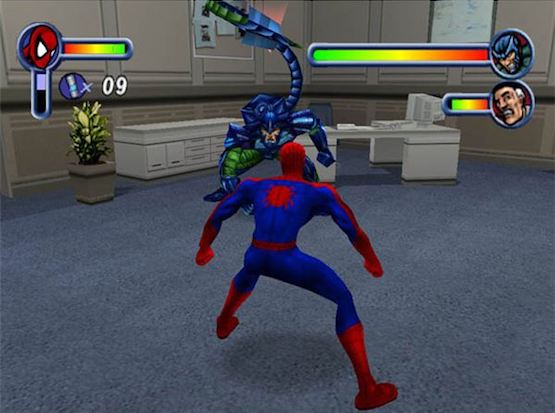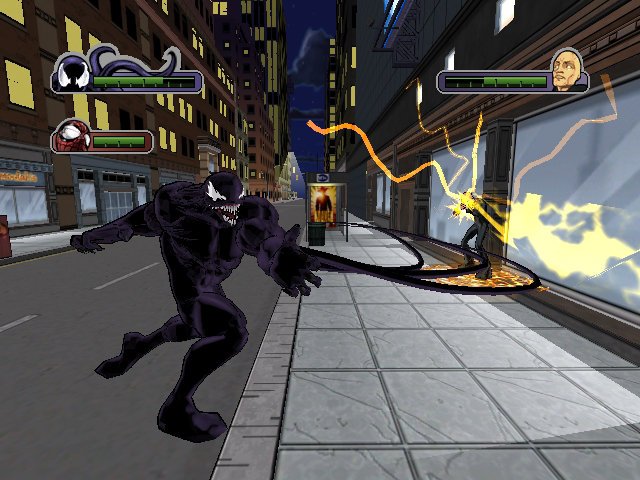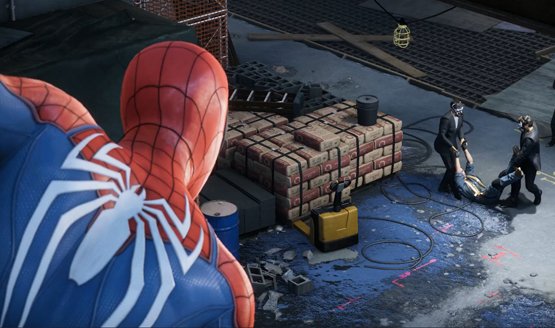Insomniac’s Spider-Man video game was announced at E3 2016 and was shown off to a rousing applause, which is no surprise to anyone who knows the slew of titles he has starred in throughout the years. I knew we would be waiting a bit for this title, so it was back to replaying the older entries for me to help stave off my excitement. I’ve played almost all of the web-head’s adventures, save for some of the odd titles on the Amiga and C64 or mobile devices—because let’s face it, I have to draw the line somewhere. Going back through most of these though—the bad entries, as well as the good—I’ve seen that there are many elements in the various installments that should be brought to the new title in hopes of making it great. I hope they looked back as well and implement a few of the things I found from past Spider-Man games.
Spider-Man’s first foray onto consoles was through the Atari, a less than stellar experience and far cry from the potential the character has, but interesting for the time. The aforementioned PC entries tried to do some neat things as well, even the Questprobe text adventure game, but no one should lose any sleep over missing out on these. I think the spectacular one got his first real shake on the Nintendo Game Boy with The Amazing Spider-Man (1990) and proceeded to leave his mark with several good entries for the 8 and 16-bit eras, at least in the beat ‘em up and action genres, but what we really want to talk about are his exploits in 3D. The first game to tackle that, and the project that laid the groundwork for almost every title that followed in the same franchise, was Neversoft’s Spider-Man (2000). After that, fans had a good idea of what a true adventure for the wall-crawler should be like: in looks, sound, feeling, and environment, the bar had been raised with new technology and Peter Parker’s world would never be simple again.
Going 3D

Starting with the meat of the game, we need to look at how it is played. The two major focuses of the footage players have seen so far have been on web-swinging and combat. Taking out goons as Spider-Man can be such a satisfying feeling and the best games give you multiple ways to do that. I love how the new game seems to have increased the use of gadgets and web-based technology, hopefully giving the player more maneuvers and enough techniques for any situation while saving the city. Spider-Man Web of Shadows (2008) has some fantastic fighting in it and allows Parker to stretch his arms, legs, and webs to take down the enemy. The games that do this part right allow a good mixture of punches and kicks, as well as tying up, tripping, or temporarily holding targets for crowd control while the player dispenses justice with a good combo system or systematic juggling, letting Spidey show off some of that strength and agility his powers grant him. A lot of attention has been put on Batman’s prowess due to combat in the Arkham games, but Marvel’s mascot should be able to make this look even more epic.
Web-swinging is probably the next most important thing, and I don’t think I’m allowed to talk about this without mentioning Spider-Man 2 (2004), and how that revolutionized the way players traversed virtual New York City. That game set the trend for momentum-based web-movement and so many other titles featuring the character have taken from them. Not all though, as Amazing Spider-Man 2 (2014) feels a bit on-rails in comparison. Players want to feel like Spider-Man when they sling around the city, which requires a sense of control while flowing freely and still putting in realistic limitations like gravity and architecture. I love that games since then have made it where Spidey can’t web-swing as well in rural areas and goes faster near downtown, around skyscrapers and other tall structures. This aspect is very important, because I want to feel like I can casually swing and explore while enjoying that freedom of an open world, or go fast and flip through buildings, like the E3 footage showed, while I’m under the crunch of a mission or reaching a goal. How missions work and their mechanics are a big deal too, but those are such a mix. Just cut out races, too many timed events, and don’t make me deliver pizzas or swing through hoops again please. I was surprised that for as much as it seemed to let people down, Spider-Man 3 (2007) actually has some of the most fulfilling side objectives and quests. My other note here is on boss battles, and there are too many to single out a game for having several good ones, but the encounters I remember most remember the fact that Spider-Man is all about using his abilities in a creative way and being able to maneuver around an environment, since he can swing and stick to walls. That might sound like video game 101 stuff, but it amazes me how many boss battles in superhero games don’t take advantage of this.
The Importance of Aesthetics

Firstly, I like the look of the new game a lot. It’s realistic enough to wow from that standpoint, fun and colorful where it needs to be, Peter has a great suit, and Mr. Negative’s effects were particularly cool. This will work well, even if I am often touting the look of games like Ultimate Spider-Man (2005), which had a cel-shaded animation (resembling the talented Mark Bagley’s work) and used a comic book paneling style for the cutscenes, reminding me of how Spider-Man and Venom: Maximum Carnage (1994) did it back on the SNES. As much as I love those ideas though, a different approach won’t hurt, and it looks great so far.
Though he may have an ego in some areas, Peter isn’t afraid to share the page or screen with his fellow Marvel heroes. A couple of the aforementioned games allow the player to take control of Venom, while Spider-Man joins other versions of himself in the excellent Shattered Dimensions (2010), not to mention a slew of other heroes in the Ultimate Alliance games, and there are so many cameos from Black Cat, Captain America, Daredevil and even Blade. So who will the new game see cameo outside of the Spider-Verse? Will we control anyone else—other than Mary Jane—like how Amazing Spider-Man (2012) went as far as making Stan Lee playable? Okay, that may have been a little far, but it was entertaining. Costumes are important also, and many games from the PS1 classic to Amazing Spider-Man 2 (2014) have made sure that our hero has his choice of outfits for every occasion, with some even having different strengths or abilities. I want more of this in the new one because it can add to the fun of a game and its replay value, like built-in cheat codes.
The writing and story needs to be strong, obviously, which is probably why I liked that Ultimate Spider-Man (2005) brought in Brian Michael Bendis, the writer for the books at the time, to help. That script needs good humor to match Spidey’s banter as well, and I have to give the Lego version of the bug some credit for almost making me laugh. Several past titles have had a narrator, from Peter himself and Stan Lee to Bruce Campbell even. While it is a very comic book thing to do, I don’t think this installment needs it if we are sticking to a more serious tone. It does need some excellent music though, and I’m huge on what Spider-Man (2001) had going for it, and that opening theme to Amazing Spider-Man on the Amiga was great, while most of the games have some wonderful theme remixes that are so 90s. Also on the audio side, voice acting is really important, producing good performances. I love having the original actor from the 90s Spider-Man cartoon come back to play the 2099 version for the wall-crawler, and the Sam Raimi movie tie-ins did it right by getting the actual actors to do their parts for the games—even if they did sound emotionless half the time. I think the new guy will do fine, but for a laugh, check out some of that voice acting on Web of Shadows (2008). It may have some bad dialogue and performances, but what it did well was letting fans choose to play a good or bad Spider-Man, and as cool as that was, it is gimmicked around the symbiote.
Insomniac has the opportunity to do something special by looking at the past. I want this new game to do all of these things, while also making its own path. It can be difficult doing things as equally fun and interesting while remaining as different as it wants to be, but the studio is talented enough to pull it off. That’s what will make it the entry the one we talk about the most for a long time.




